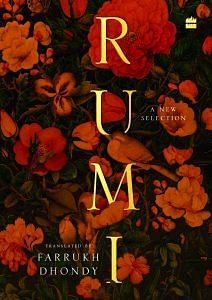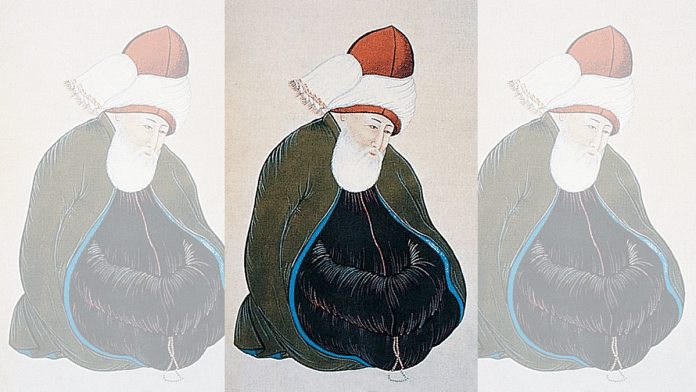Shams-u-Tabrez has left in his Maqalut, a sort of autobiography, an account of his interaction with Rumi. He seems to say that he had encountered Rumi in Damascus, after the death of his father Baha-al-din Valad and before Rumi succeeded him as the Mowlana, the professor-preacher of Konya. In an intermediate period when Rumi was not old enough to take his father’s place, he called on Borhan-al-Din, a disciple of his father, to lecture in Konya. Burhan sent the young Rumi to Damascus to further his studies in theology. It was there, according to Shams that he first encountered Rumi and was impressed by the young man’s knowledge and interpretations. Shams writes that they didn’t exchange more than a greeting at that point, but only fifteen years later made the acquaintance that would alter Rumi’s entire religious outlook and give the world his poetic works.
On reading Rumi’s works and his pronouncements on his relationship with Shams any reader would get the distinct impression that the man he calls the master and the king and his lover is the superior or at least guiding partner in their relationship. When Shams disappears from Konya, threatened by Rumi’s pupils who are bewildered by the change in their teacher’s stance and demeanour, Rumi mourns his departure and represents it as heartbreak and ultimate loss.
And yet the account of their relationship by Shams himself in the Maqalut paints a different picture. Shams expresses deep respect for Rumi’s acumen, learning and intellect and specifically says that there was no question of him being the master and Rumi being the pupil. He does go on to say that Rumi’s reference to other scholars’ philosophizing would get in the way of his progress towards the oneness with the infinite that Sufis seek.
I only came across Shams’s very detailed description of his relationship with Rumi on reading the masterful and comprehensive work Rumi by Franklin D. Lewis, Associate Professor at the University of Chicago (Rumi: Past and Present, East and West; The Life, Teachings and Poetry of Jalal al- Din Rumi published by Oneworld Oxford—and this is by way of acknowledgement of this extensive scholarship).
Shams writes about entering Rumi’s household. Rumi, after the death of his first wife Gowhar Khatun, the mother of his two sons, marries a younger woman. Shams says that according to Sharia law and Islamic custom of the thirteenth century, a woman was not allowed to be in the presence of a man who was not her husband. And yet, Shams says, Rumi had no objection to his young second wife sitting at the feet of Shams and listening to his discourses.
The transformation, which contact with Shams brought about in Jalal, was not acceptable to Jalal’s congregation and possibly not even to his family. Jalal emerged from their prolonged and private discourses with what he claimed was true spiritual enlightenment. His religious conviction had taken the form of self-abnegation in the interests of union of spirit with the ‘master’ and through him with the Infinite. The forms of communication changed from logical discourse to mystical realization in verse and song and even in dance.
It is perhaps through this transformation, when Jalal begins to compose verses in ecstatic form, that his appellation came to be altered from Mowlana Jalal-al-Din to ‘Rumi’.
Also read: Two strokes of a crowbar—that’s all it took to smash the Awadh princess’ resting place
For some of his pupils and followers, this transformation was perceived as a defiance of lucidity and something close to blasphemy. It generated amongst Rumi’s congregation a deep antagonism to Shams.
Threatened by this hostility, Shams left Konya and disappeared. His absence was acutely felt by Rumi, whose muse, it seems, had departed because as is evident from the chronological evidence, he wrote very little at this time. Finally, news reached him that Shams was in Syria in Damascus and Rumi sent his son Sultan Valad to go there and persuade him to return.
The persuasion and the assurances must have worked as Shams did return to Konya.
By this time, the hostile disciples of Rumi realized that his transformation and dedication to the form of ecstatic Sufism that Shams had brought to him would not change. Things wouldn’t go back to what they were before Shams-u-Tabrez entered Konya and their Mowlana’s spiritual ‘understanding’.
By this time, a year or more since his reappearance in Konya, Shams had taken a young woman, Kimia Khatun who had been brought up in the Valad household, as his wife.
This wife died soon after and the disciples and even Rumi’s family members accused Shams of neglecting his young wife’s health, which led to her death.
It was perhaps this episode which culminated in threats to Shams’s life, which resulted in his second and ultimate flight from Konya. Though Rumi initiated searches for his whereabouts, he never found Shams. It is likely that he had been murdered and the body disposed of as he disappeared without a trace.
By the time of Shams’s disappearance, Rumi had written a substantial number of ghazals to him. Through his period of despondency and grieving for Shams, Rumi expressed his love for Shams by beginning to write the Diwan-e-Shams, a book dedicated to his inspiration and a gateway into this selfless spiritual quest.
 This excerpt from ‘Rumi: A New Selection’, translated by Farrukh Dhondy, has been published with permission from HarperCollins Publishers.
This excerpt from ‘Rumi: A New Selection’, translated by Farrukh Dhondy, has been published with permission from HarperCollins Publishers.




